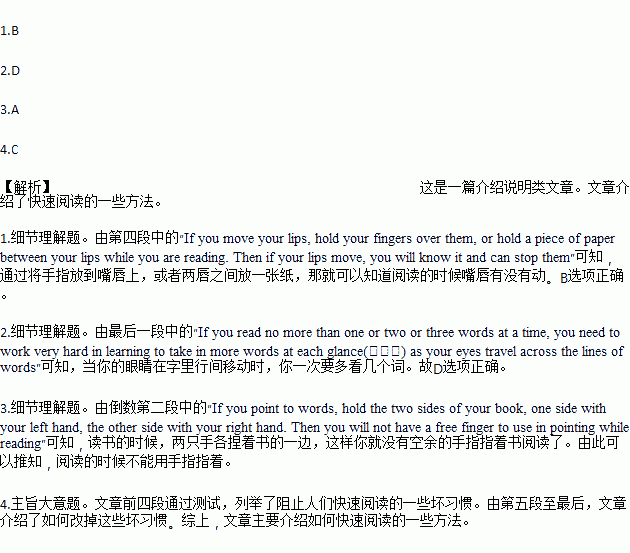题目内容
THE WAY TO READ FAST
Perhaps you have been told about some habits(习惯) which stop a person reading fast and have been strongly asked to break those habits which you might have.
Do you still have any of these bad habits7 Check yourself by answering "yes" or "no" to these questions:
1. Do you move your lips(嘴唇) when reading silently?
2. Do you point to words with your finger as you read?
3. Do you move your head from side to side as you read?
4. Do you read one word at a time?
If you answer "yes" to any of these questions, start at once to break the habit.
If you move your lips, hold your fingers over them, or hold a piece of paper between your lips while you are reading. Then if your lips move, you will know it and can stop them.
If you point to words, hold the two sides of your book, one side with your left hand, the other side with your right hand. Then you will not have a free finger to use in pointing while reading. If you move your head, place your chin(下巴)in one hand, and hold your head still(不动地).
If you read no more than one or two or three words at a time, you need to work very hard in learning to take in more words at each glance(看一眼) as your eyes travel across the lines of words.
1.You may hold your fingers over your lips while reading
A. to hold a piece of paper between them B. to feel whether y our lips move or not
C. to tell others to be silent D. to stop yourself talking to others
2.When your eyes travel across the lines of words,
A. you need to read the words out B. you need to look at every word carefully
C. you need to remember every word D. you need to read several words at a time
3.When you read,
A. don’t use your finger to point to words B. don’t hold your books with your hands
C. don’t hold your head still D. don’t do any of the things mentioned(提到)above.
4.This passage mainly talks about .
A. the importance of fast reading B. the bad habits in reading
C. the way to read fast D. both A and B


 ),并在其下面写出该加的词。
),并在其下面写出该加的词。 )划掉。
)划掉。 version of the above quote. When I left her father about 12 years ago she chose to stay with him. Her father was quite angry at our breakup and so was my daughter. She exactly had nothing to do with me for about 5 years, no contact, no presents to me, no overnight stays. It broke my heart.
version of the above quote. When I left her father about 12 years ago she chose to stay with him. Her father was quite angry at our breakup and so was my daughter. She exactly had nothing to do with me for about 5 years, no contact, no presents to me, no overnight stays. It broke my heart.